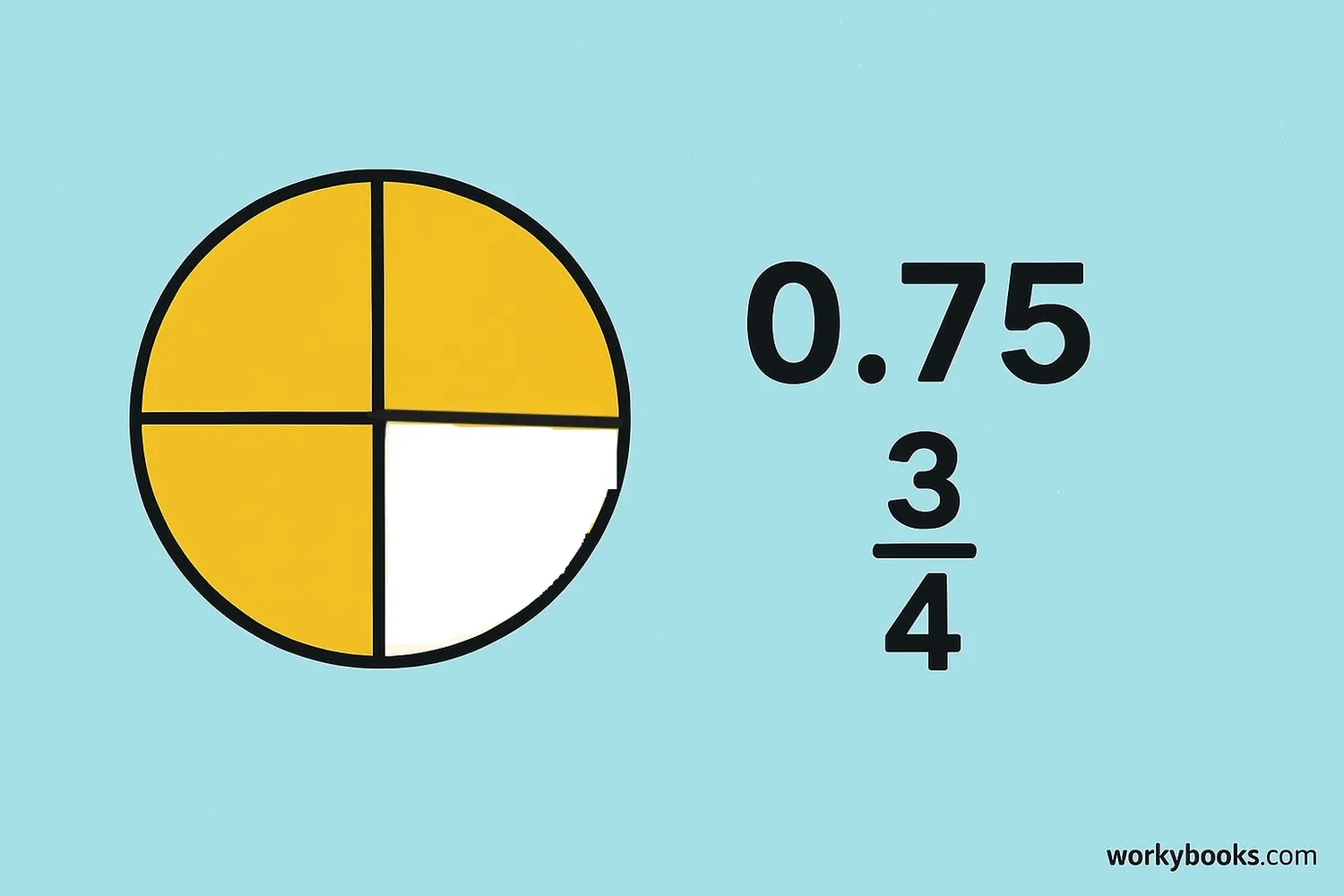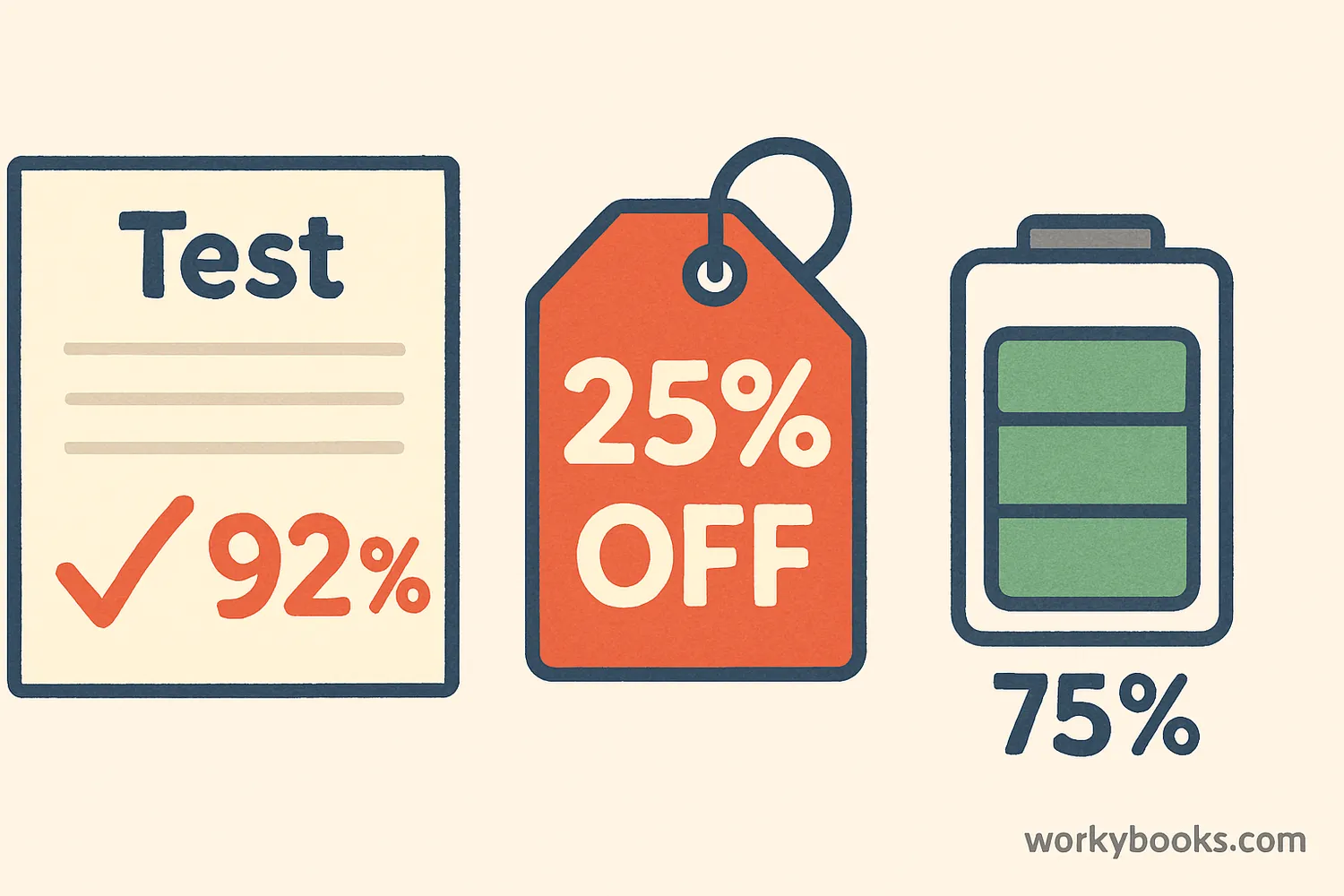Decimal to Percentage Conversion - Definition, Examples, Quiz, FAQ, Trivia
Learn to convert between decimals and percentages with simple explanations and practice activities
What is Decimal to Percentage Conversion?

Converting decimals to percentages helps us express numbers in a different way that's often easier to understand.
Decimals show parts of a whole using a decimal point (like 0.75).
Percentages show parts per hundred using a percent sign (like 75%).
Why do we convert? Percentages are helpful when we want to compare different amounts or understand proportions quickly. For example, saying "50% off" is clearer than "0.5 discount".
The word "percent" means "per hundred", so 75% is the same as 75 per hundred, which we can write as 75/100 or 0.75.
Key Concept
Percent means "per hundred". To convert a decimal to a percentage, we're finding out how many parts per hundred it represents.
How to Convert Decimals to Percentages
Converting decimals to percentages is simple with this easy method:
Conversion Formula
To convert any decimal to a percentage, multiply it by 100 and add the percent sign.
Example: Convert 0.85 to a percentage
Step 1: Start with the decimal → 0.85
Step 2: Multiply by 100 → 0.85 × 100 = 85
Step 3: Add the percent sign → 85%
It's that simple! You've converted a decimal to a percentage.
Remember
Multiplying by 100 moves the decimal point two places to the right. That's why 0.25 becomes 25%, and 0.7 becomes 70%!
Conversion Examples

Let's practice conversion with some real-world examples:
Example 1: You scored 0.92 on your math test. What is this as a percentage?
Solution: 0.92 × 100 = 92%
Example 2: A store offers 0.25 discount. What percentage discount is this?
Solution: 0.25 × 100 = 25% discount
Example 3: Your tablet battery shows 0.75 charge. What percentage is this?
Solution: 0.75 × 100 = 75% charged
Example 4: Convert 0.6 to a percentage
Solution: 0.6 × 100 = 60%
Example 5: Convert 1.25 to a percentage
Solution: 1.25 × 100 = 125% (this means more than one whole!)
Common Decimal to Percentage Conversions
| Decimal | Percentage |
|---|---|
| 0.01 | 1% |
| 0.05 | 5% |
| 0.10 | 10% |
| 0.25 | 25% |
| 0.50 | 50% |
| 0.75 | 75% |
| 0.99 | 99% |
| 1.00 | 100% |
| 1.50 | 150% |
Conversion Tip
Notice that 0.50 becomes 50% and 0.25 becomes 25%. The decimal point moves two places to the right!
Converting Percentages to Decimals
Sometimes we need to convert percentages back to decimals. Here's how:
Reverse Conversion Formula
To convert any percentage to a decimal, divide by 100 and remove the percent sign.
Example: Convert 45% to a decimal
Step 1: Start with the percentage → 45%
Step 2: Remove the percent sign → 45
Step 3: Divide by 100 → 45 ÷ 100 = 0.45
So 45% equals 0.45 as a decimal. This is the reverse of what we did earlier!
Remember
Dividing by 100 moves the decimal point two places to the left. That's why 25% becomes 0.25, and 8% becomes 0.08!
Conversion Practice Quiz
Test your conversion skills with this 5-question quiz. Choose the correct answer for each question.
Frequently Asked Questions
Here are answers to common questions about decimal and percentage conversion:
Math Trivia
Discover interesting facts about percentages and decimals:
Origin of Percentages
The concept of percentages dates back to ancient Rome where computations were made using fractions of 100. The term "percent" was first used in the 16th century by Italian mathematicians.
Percentages in Nature
Did you know that about 60% of the human body is water? And the Earth's atmosphere is approximately 78% nitrogen and 21% oxygen. Percentages help scientists describe our world!
Percentages in Space
Astronomers use percentages to describe the composition of planets. For example, about 71% of Earth's surface is covered with water, while Mars is about 95% carbon dioxide in its atmosphere.
Highest Percentage?
The highest possible percentage is theoretically unlimited! While we often think of 100% as the maximum, percentages can exceed 100. For example, if you have $200 from an original $100, that's 200%!


